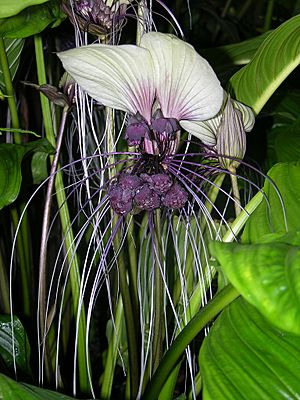White batflower facts for kids
Quick facts for kids White batflower |
|
|---|---|
 |
|
| Scientific classification | |
| Genus: |
Tacca
|
| Species: |
integrifolia
|
| Synonyms | |
|
|
The white batflower (scientific name: Tacca integrifolia) is a really cool and unusual flowering plant. It's part of the yam family, called Dioscoreaceae. You can find it growing naturally in the warm, wet rainforests of Asia. An English plant expert named John Bellenden Ker Gawler first described this unique plant way back in 1812. It gets its name "batflower" because its dark, wide flowers look a bit like a bat in flight!
What it Looks Like
The white batflower is a type of herb that grows from a thick, underground stem called a rhizome. Imagine a thick, horizontal root that helps the plant spread.
- Leaves: Its leaves grow on long stems. They are shaped like long ovals or spears, about 50 by 20 cm (20 by 8 in) (that's about 20 by 8 inches). They have pointed tips and narrow bases.
- Flowers: The flowers grow on a tall stalk, called a scape, which is about 55 cm (22 in) (about 22 inches) long. At the top of this stalk, there are two large, upright leaves called involucral bracts. These bracts are white with pretty purple veins.
- The actual flowers hang downwards in a cluster. Among them are long, thin, thread-like bracts that look like whiskers.
- Each flower has a tube-shaped part that is purplish-black, about 1 to 2 cm (0.4 to 0.8 in) (0.4 to 0.8 inches) long. It has six "petals" (called perianth lobes) arranged in two groups of three. The outer three are narrow, and the inner three are wider and more rounded.
- Fruits: After the flowers, the plant produces fleshy berries that are about 2 cm (0.8 in) (0.8 inches) long. Inside these berries are seeds with six ridges, and you can still see parts of the flower attached to them.
Where it Grows
The white batflower is native to the hilly areas of tropical and subtropical Asia. You can find it in many countries, including:
- Pakistan
- Eastern India
- Sri Lanka
- Bhutan
- Bangladesh
- Nepal
- Myanmar
- Malaysia
- Thailand
- Cambodia
- Vietnam
- Eastern China
It likes to grow in the shady parts of humid rainforests, often among the fallen leaves on the forest floor. It prefers places that are always warm and wet.
Life Cycle and How it Spreads
The white batflower has some interesting ways it interacts with its environment.
- Pollination: The parts of the flower that produce pollen (the stamens) are shaped like little helmets. Along with the flat-topped parts that receive pollen (the stigma lobes), they might form a kind of trap for insects. The flowers also give off a sweet, musky smell. This smell probably attracts flies, which then help to pollinate the flowers by carrying pollen from one flower to another.
- Seed Dispersal: After the flowers are pollinated, the tall stalk holding the fruits bends over, so the developing berries rest on the ground. These berries are dull in color and have soft, jelly-like insides. It's thought that small animals like rodents and other small mammals eat these fruits. When they do, they help spread the seeds to new places, allowing more white batflowers to grow!

